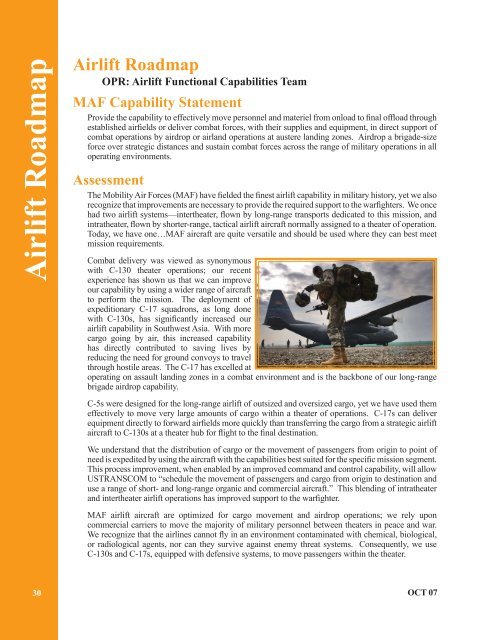Air Mobility Plan, 2008 - The Black Vault
Air Mobility Plan, 2008 - The Black Vault
Air Mobility Plan, 2008 - The Black Vault
You also want an ePaper? Increase the reach of your titles
YUMPU automatically turns print PDFs into web optimized ePapers that Google loves.
<strong>Air</strong>lift Roadmap<br />
<strong>Air</strong>lift Roadmap<br />
OPR: <strong>Air</strong>lift Functional Capabilities Team<br />
MAF Capability Statement<br />
Provide the capability to effectively move personnel and materiel from onload to final offload through<br />
established airfields or deliver combat forces, with their supplies and equipment, in direct support of<br />
combat operations by airdrop or airland operations at austere landing zones. <strong>Air</strong>drop a brigade-size<br />
force over strategic distances and sustain combat forces across the range of military operations in all<br />
operating environments.<br />
Assessment<br />
<strong>The</strong> <strong>Mobility</strong> <strong>Air</strong> Forces (MAF) have fielded the finest airlift capability in military history, yet we also<br />
recognize that improvements are necessary to provide the required support to the warfighters. We once<br />
had two airlift systems—intertheater, flown by long-range transports dedicated to this mission, and<br />
intratheater, flown by shorter-range, tactical airlift aircraft normally assigned to a theater of operation.<br />
Today, we have one…MAF aircraft are quite versatile and should be used where they can best meet<br />
mission requirements.<br />
Combat delivery was viewed as synonymous<br />
with C-130 theater operations; our recent<br />
experience has shown us that we can improve<br />
our capability by using a wider range of aircraft<br />
to perform the mission. <strong>The</strong> deployment of<br />
expeditionary C-17 squadrons, as long done<br />
with C-130s, has significantly increased our<br />
airlift capability in Southwest Asia. With more<br />
cargo going by air, this increased capability<br />
has directly contributed to saving lives by<br />
reducing the need for ground convoys to travel<br />
through hostile areas. <strong>The</strong> C-17 has excelled at<br />
operating on assault landing zones in a combat environment and is the backbone of our long-range<br />
brigade airdrop capability.<br />
C-5s were designed for the long-range airlift of outsized and oversized cargo, yet we have used them<br />
effectively to move very large amounts of cargo within a theater of operations. C-17s can deliver<br />
equipment directly to forward airfields more quickly than transferring the cargo from a strategic airlift<br />
aircraft to C-130s at a theater hub for flight to the final destination.<br />
We understand that the distribution of cargo or the movement of passengers from origin to point of<br />
need is expedited by using the aircraft with the capabilities best suited for the specific mission segment.<br />
This process improvement, when enabled by an improved command and control capability, will allow<br />
USTRANSCOM to “schedule the movement of passengers and cargo from origin to destination and<br />
use a range of short- and long-range organic and commercial aircraft.” This blending of intratheater<br />
and intertheater airlift operations has improved support to the warfighter.<br />
MAF airlift aircraft are optimized for cargo movement and airdrop operations; we rely upon<br />
commercial carriers to move the majority of military personnel between theaters in peace and war.<br />
We recognize that the airlines cannot fly in an environment contaminated with chemical, biological,<br />
or radiological agents, nor can they survive against enemy threat systems. Consequently, we use<br />
C-130s and C-17s, equipped with defensive systems, to move passengers within the theater.<br />
30<br />
OCT 07
















